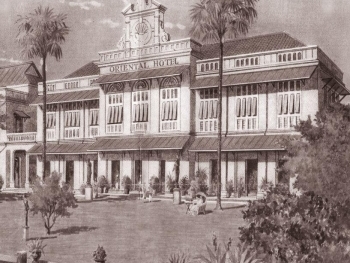Museums have long been the gateways to history, culture, and art, preserving humanity’s most treasured artifacts for future generations. While many of today’s museums are modern institutions, some of the world’s oldest museums date back centuries, offering a glimpse into how people have preserved and studied history over time.
From ancient collections of curiosities to grand institutions founded by monarchs and scholars, these museums have shaped how we understand and appreciate our shared past. Let’s explore the oldest museums in the world and the fascinating stories behind them.
1. The Capitoline Museums (Rome, Italy) – Established in 1471
The World’s First Public Museum
Founded by: Pope Sixtus IV
Official Opening: 1734 under Pope Clement XII
Why It’s Famous: Home to some of the most important Roman sculptures and artifacts in history
The Capitoline Museums, located atop Rome’s Capitoline Hill, are considered the oldest public museum in the world. Though their origins date back to 1471, when Pope Sixtus IV donated a collection of ancient Roman bronze statues, they were formally opened to the public in 1734.
Fascinating Artifacts:
🏛 The Capitoline Wolf – A famous bronze statue of Romulus and Remus, the legendary founders of Rome, suckling from a she-wolf.
🗿 The Colossal Statue of Constantine – A massive fragmentary statue of Emperor Constantine the Great.
🎨 Caravaggio’s The Fortune Teller – A masterpiece of Baroque painting.
Historical Significance:
The museum was one of the first to make art and artifacts available to the public, setting a precedent for future museums worldwide.
2. The Vatican Museums (Vatican City) – Established in 1506
A Treasure Trove of Renaissance and Ancient Art
Founded by: Pope Julius II
Official Opening: 16th century
Why It’s Famous: Home to the Sistine Chapel, Raphael Rooms, and an extensive collection of ancient sculptures
The Vatican Museums began with Pope Julius II’s acquisition of the Laocoön and His Sons statue in 1506. Over centuries, the museum expanded to house one of the most significant collections of art and historical artifacts in the world.
Fascinating Artifacts:
🖌 Michelangelo’s Sistine Chapel Ceiling – One of the most famous frescoes ever painted, depicting The Creation of Adam.
🏺 The Apollo Belvedere – An iconic Greek sculpture admired during the Renaissance.
🎭 The Raphael Rooms – Stunning frescoes by Raphael, including The School of Athens.
Historical Significance:
The Vatican Museums are not just a museum but a reflection of papal power and influence, showcasing art that spans over two millennia.
3. The Ashmolean Museum (Oxford, England) – Established in 1683
The World’s First University Museum
Founded by: Elias Ashmole
Official Opening: 1683
Why It’s Famous: Houses one of the greatest collections of Egyptian and Anglo-Saxon artifacts
The Ashmolean Museum of Art and Archaeology at Oxford University was the first university museum in the world, created to house the collection of Elias Ashmole, an English antiquarian and scholar.
Fascinating Artifacts:
🏺 The Alfred Jewel – A stunning Anglo-Saxon relic from the 9th century.
🎭 Egyptian Mummies and Sarcophagi – One of the largest collections outside of Egypt.
🖼 Works by Raphael and Leonardo da Vinci – A remarkable collection of Renaissance art.
Historical Significance:
The Ashmolean set a precedent for academic museums, emphasizing the importance of collecting artifacts for scholarly study and research.
4. The British Museum (London, England) – Established in 1753
The Birth of the Modern Museum
Founded by: Sir Hans Sloane
Official Opening: 1759
Why It’s Famous: Home to some of the most significant archaeological finds in human history
The British Museum was founded when Sir Hans Sloane, a physician and collector, donated his 71,000-object collection to the British government. It became the first national public museum in the world and remains one of the most visited institutions today.
Fascinating Artifacts:
🗿 The Rosetta Stone – The key to deciphering ancient Egyptian hieroglyphs.
🏛 The Elgin Marbles – Sculptures from the Parthenon in Athens.
🎭 The Lewis Chessmen – Intricately carved Viking-era chess pieces from the 12th century.
Historical Significance:
The British Museum pioneered the idea of a national museum, open to the public free of charge, setting the standard for modern institutions.
5. The Hermitage Museum (St. Petersburg, Russia) – Established in 1764
The Imperial Collection of the Russian Tsars
Founded by: Empress Catherine the Great
Official Opening: 1852
Why It’s Famous: One of the largest and most prestigious art museums in the world
The Hermitage Museum started as Catherine the Great’s private collection of art, but it quickly grew into one of the most extensive and valuable collections in the world. It officially became a public museum in 1852.
Fascinating Artifacts:
🖼 Da Vinci’s Madonna Litta – One of the few Leonardo da Vinci paintings in Russia.
🏛 The Peacock Clock – A mechanical golden masterpiece from the 18th century.
🎨 Works by Rembrandt, Van Gogh, and Monet – A breathtaking collection of European art.
Historical Significance:
The Hermitage symbolizes Russia’s cultural ambitions, showcasing a mix of Western and Eastern art traditions.
6. The Louvre (Paris, France) – Established in 1793
The World’s Most Famous Museum
Founded by: The French Republic
Official Opening: 1793
Why It’s Famous: Home to the Mona Lisa, Venus de Milo, and countless masterpieces
Originally a royal palace, the Louvre was transformed into a museum after the French Revolution, making it one of the first truly public museums. It remains the most visited museum in the world today.
Fascinating Artifacts:
🎨 The Mona Lisa (Leonardo da Vinci) – The world’s most famous painting.
🗿 The Venus de Milo – An exquisite ancient Greek sculpture.
🎭 The Winged Victory of Samothrace – A dramatic Hellenistic masterpiece.
Historical Significance:
The Louvre set the precedent for modern museums, shifting from private collections to public institutions dedicated to education and culture.
Museums as Gateways to History
The world’s oldest museums were more than just places to store artifacts—they were institutions that shaped how we study, preserve, and appreciate history. Whether founded by popes, monarchs, scholars, or revolutionaries, these museums represent humanity’s commitment to knowledge and culture.
As technology and digital innovations reshape the museum experience, the legacy of these historic institutions lives on, ensuring that future generations will continue to explore and learn from the past.



